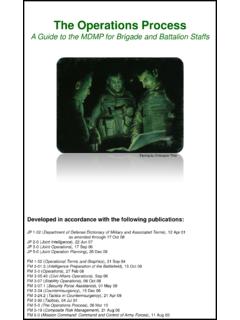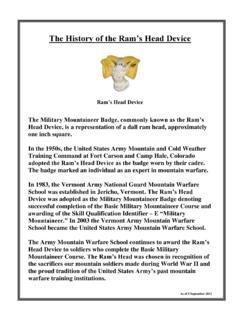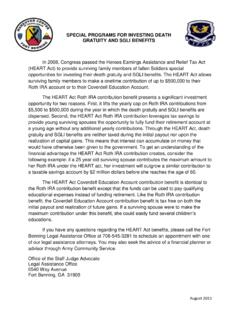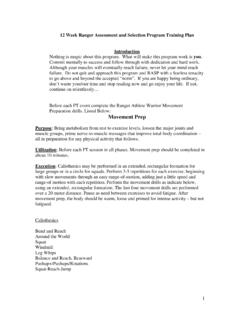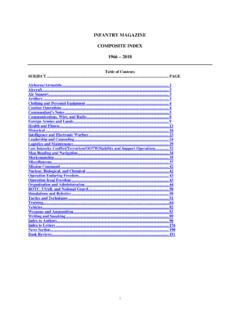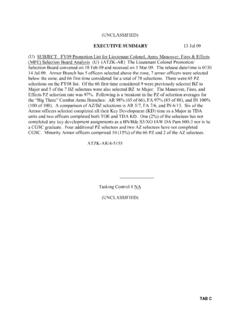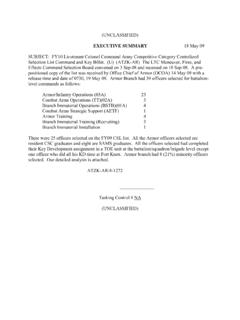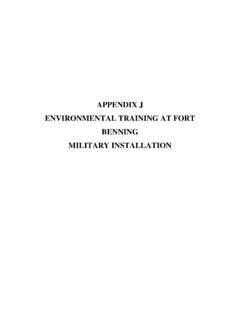Transcription of Decision-Support Planning and Tools: Planning to Support ...
1 Decision-Support Planning and Tools: Planning to Support decision -Making by CPT Gary M. Klein and CPT Alan P. Hastings As the Army increases its focus on decisive action, more units are emphasizing Decision-Support templates and matrices as part of the Planning process. Unfortunately, these tools have only minimally impacted tactical decision -making and mission outcomes because leaders are using these tools as another synchronization tool rather than focusing on decision When used correctly, Decision-Support tools link directly to the information-collection (IC) plan, facilitate the creation of branch plans prior to execution and assist the commander s decision -making.
2 All leaders strive to Support decision -making, so what are the challenges to accomplishing this? One is the sequence of Decision-Support Planning within the military decision -making process (MDMP). Staffs create friendly Decision-Support tools late in the Planning process during course-of-action (CoA) analysis, according to Given time constraints at this point, staffs often create these tools hastily, focusing on routine synchronization triggers instead of anticipating significant transitions or branch plans. Also, the sequence of IC Planning and Decision-Support Planning creates a frequent disconnect between these two plans.
3 To overcome these challenges staffs should develop decision points earlier in the Planning process and practice MDMP more to recognize when and how to deviate from doctrine. We will recommend one such technique to alter existing doctrine and enable Decision-Support Planning . We will start by reviewing the current doctrine that outlines Decision-Support Planning and a case study describing its typical, doctrinal execution. This review will explore the aforementioned challenges regarding Decision-Support Planning . Then, we will review a foreign humanitarian assistance (FHA) contingency plan and summarize decision -point tactics (DPTs) as additional case studies.
4 These latter case studies will demonstrate potential adjustments to Decision-Support Planning . Finally, we will summarize some of the advantages and disadvantages to the recommended adjustments to Decision-Support Planning . Doctrinal review When seeking doctrinal information about Planning , MDMP and Decision-Support matrices (DSMs) and templates (DSTs), leaders typically reference Army Doctrinal Reference Publication (ADRP) 5-0, The Operations Process, and Field manual (FM) 6-0, Commander and Staff Organization and Operation. The Operations Process is the Army s primary reference for Planning , preparing, executing and assessing, and it states that a DST is [a] combined intelligence and operations graphic based on the results of wargaming.
5 The [DST] depicts decision points, timelines associated with movement of forces and the flow of the operation, and other key items of information required to execute a specific friendly [CoA] ([Joint Publication (JP)] ). Part of the [DST] is the [DSM]. A [DSM] is a written record of a wargamed [CoA] that describes decision points and associated actions at those decision points. The [DSM] lists decision points, locations of decision points, criteria to be evaluated at decision points, actions that occur at decision points and the units responsible to act on the decision points. 3 Commander and Staff Organization and Operation, the Army s primary reference for MDMP and plans formats, references DSTs as a result of wargaming that portray[s] key decisions and potential actions that are likely to arise during the execution of each CoA.
6 4 These descriptions summarize DSTs and DSMs and what they contain. However, to find more details or an example, planners must follow the reference in ADRP 5-0 to JP , Joint intelligence Preparation of the Operational Environment (JIPOE), and its Army equivalent, Army Techniques Publication (ATP) , intelligence Preparation of the Battlefield/Battlespace (IPB). The IPB and JIPOE manuals present Decision-Support tools within the larger intelligence - Planning process. They begin their description with the four steps of IPB, when staffs create a modified combined obstacle overlay (MCOOs), threat CoA(s) and an event template (eventemp), which depicts key differences in the threat CoAs.
7 After completing these IPB estimates, the staff creates an IC plan to answer intelligence gaps and narrow the range of possible threat CoAs, both of which influence the commander s decision -making. The staff creates these four products (the MCOO, threat CoA(s), eventemp and IC plan) during mission analysis and will use the eventemp later to develop the Decision-Support plan. However, friendly decision points and Decision-Support tools are not created until CoA analysis, according to This gap in time between IC Planning during mission analysis (Figure 1, Star 1) and Decision-Support Planning during CoA analysis (Figure 1, Star 2) creates a potential disconnect between these two plans, especially since units initiate IC prior to beginning Decision-Support Planning .
8 Figure 1. The MDMP Planning process and IC Planning and execution align as they occur sequentially and simultaneously. Note the gap in time between when a unit initiates its IC and when the staff develops its Decision-Support plan. The doctrinal- Planning sequence may be suitable when friendly branch plans are slight adjustments to a well-formulated plan based on minor differences in the threat situation. However, plans rarely survive first contact with the enemy, so leaders should emphasize Decision-Support Planning to enable more flexible plans. Case study: doctrinal Decision-Support Planning The following Joint Readiness Training Center (JRTC) brigade-defense case study highlights a typical Decision-Support plan.
9 In December 2014, JRTC conducted Rotation , a Joint Conflict and Training Simulation exercise, involving 21st Infantry Division ( , the JRTC headquarters and staff), 56th Stryker Brigade Combat Team (SBCT), two constructive brigade combat teams (BCTs) and a number of other brigade and battalion supporting units. Operations Group s Task Force 4 (cavalry squadron) roleplayed the Arianan 181st Brigade Tactical Group (BTG), the opposing force for this exercise. This case study is presented from 181st BTG s In the exercise scenario, 181st BTG attacked into the sovereign country of Atropia and established a defense to protect the flank of subsequent Arianan units that would continue the attack.
10 To counter this, 21st Infantry Division attacked 181st BTG to re-establish the international boundary. The 181st BTG planned its defense using Army MDMP Planning doctrine, including the development of its IC plan during mission analysis and DST during CoA analysis. The 181st intelligence section analyzed its area of operations to understand the environmental effects and then analyzed its threat, 21st Infantry Division. During this analysis, it created its MCOO and developed threat most-likely and most-dangerous CoAs. The route along which 21st Infantry Division would attack differentiated the two threat CoAs the most.
